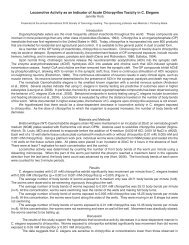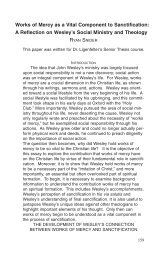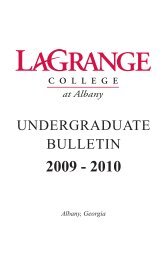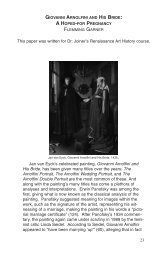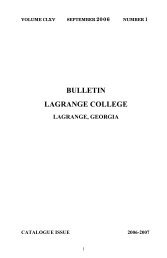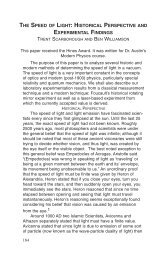Alexander The Great in Art
Alexander The Great in Art
Alexander The Great in Art
Create successful ePaper yourself
Turn your PDF publications into a flip-book with our unique Google optimized e-Paper software.
pos, for, accord<strong>in</strong>g to the historian Plutarch, “only Lysippos, it seems, brought out<br />
his real character <strong>in</strong> the bronze and gave form to his essential excellence” (Plutarch<br />
50). In one portrait, called the Azara Herm, Lysippos characterized <strong>Alexander</strong> not as<br />
a god, as Apelles and Pyrgoteles did, but as a vigorous and thoughtful man. Accord<strong>in</strong>g<br />
to Margaret Bieber, Lysippos captured the “manl<strong>in</strong>ess and lion-like fierceness of<br />
his countenance” as well as the “softness, brightness, and melt<strong>in</strong>g glance of his eyes”<br />
(183). <strong>The</strong> Azara Herm, now <strong>in</strong> the Louvre, is recognized as <strong>Alexander</strong> because of its<br />
<strong>in</strong>scription, “<strong>Alexander</strong>, son of Philip of Macedon” (Bieber 183).<br />
Possibly the best known depiction of <strong>Alexander</strong> is the <strong>Alexander</strong> Mosaic, which<br />
was found <strong>in</strong> 1831 <strong>in</strong> the House of the Faun at Pompeii. <strong>The</strong> scene <strong>in</strong> the mosaic is<br />
that of <strong>Alexander</strong> either at the Battle of Issos <strong>in</strong> 333 BC or the Battle of Gaugamela<br />
<strong>in</strong> 331 BC, fight<strong>in</strong>g with the Persian emperor Darius (Stewart 133). Amidst the chaos<br />
and death of the battle, this scene captures the exact moment when <strong>Alexander</strong>’s<br />
charge causes Darius to retreat, and thus symbolically represents the pivotal turn<strong>in</strong>g<br />
po<strong>in</strong>t that leads to the fall of the Persians and the rise of <strong>Alexander</strong> the <strong>Great</strong>.<br />
<strong>The</strong> battle shows the bravery of <strong>Alexander</strong>, s<strong>in</strong>ce he is lead<strong>in</strong>g his army aga<strong>in</strong>st the<br />
Persians without a helmet. Darius is portrayed as weak compared to <strong>Alexander</strong> because<br />
of his gesture of entreaty and the flight of his charioteer. <strong>The</strong> dead tree <strong>in</strong><br />
the background also plays an important part <strong>in</strong> the image. For Andrew Stewart, it<br />
becomes a “metaphor for the death and dismemberment of the Persian Empire”<br />
(140). Considered to be a second-century BC copy, and portrayed so prom<strong>in</strong>ently <strong>in</strong><br />
a Roman house many years after his death, this mosaic demonstrates the endur<strong>in</strong>g<br />
appeal of <strong>Alexander</strong> the <strong>Great</strong> (Burn 40-41).<br />
Another famous representation of <strong>Alexander</strong> is that on his sarcophagus, which<br />
was made <strong>in</strong> the 4th century BC. <strong>The</strong> <strong>Alexander</strong> Sarcophagus, found at Sidon, <strong>in</strong><br />
modern-day Lebanon, was used for a royal burial, perhaps that of K<strong>in</strong>g Abdalonymos,<br />
who was <strong>in</strong>stalled on the throne by <strong>Alexander</strong> after the Battle of Issos (Webster<br />
38). Shaped like a m<strong>in</strong>iature temple with the lid patterned after a pediment, the<br />
sarcophagus has four battle and two hunt<strong>in</strong>g scenes. One scene shows a lion hunt,<br />
<strong>in</strong> which <strong>Alexander</strong> is likened to Heracles hunt<strong>in</strong>g a lion and later wear<strong>in</strong>g its sk<strong>in</strong>.<br />
Abdalonymos is probably one of the figures next to <strong>Alexander</strong>, perhaps to strengthen<br />
his own reputation and importance as a ruler (Burn 43). <strong>Alexander</strong> is also <strong>in</strong> one<br />
of the battle scenes, along with his closest friend Hephaestion. <strong>The</strong> other hunt<strong>in</strong>g<br />
scene is one of a panther, and another battle is between Greeks and Persians, with<br />
<strong>Alexander</strong> recognizable on the left (Webster 41).<br />
Regardless of who commissioned the <strong>Alexander</strong> Sarcophagus, it and the scenes<br />
on it were probably used by <strong>Alexander</strong>s’ successors, accord<strong>in</strong>g to Lucilla Burn, as<br />
a “technique of seek<strong>in</strong>g to legitimize and popularize themselves by reference to<br />
their illustrious leader” (43). Even after his death <strong>in</strong> 323 BC, <strong>Alexander</strong>’s image was<br />
recreated and glorified as one of strength, power, and div<strong>in</strong>ity. On account of his<br />
overwhelm<strong>in</strong>g popularity with the people of Greece, his god-like status, and his<br />
likeness to the hero Heracles, <strong>Alexander</strong>’s contemporaries put his image to good








